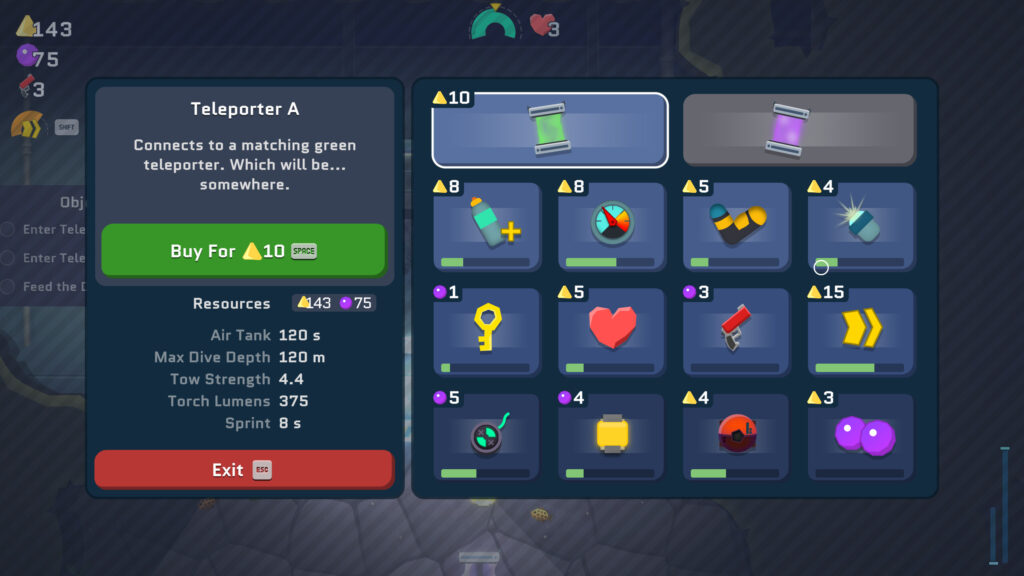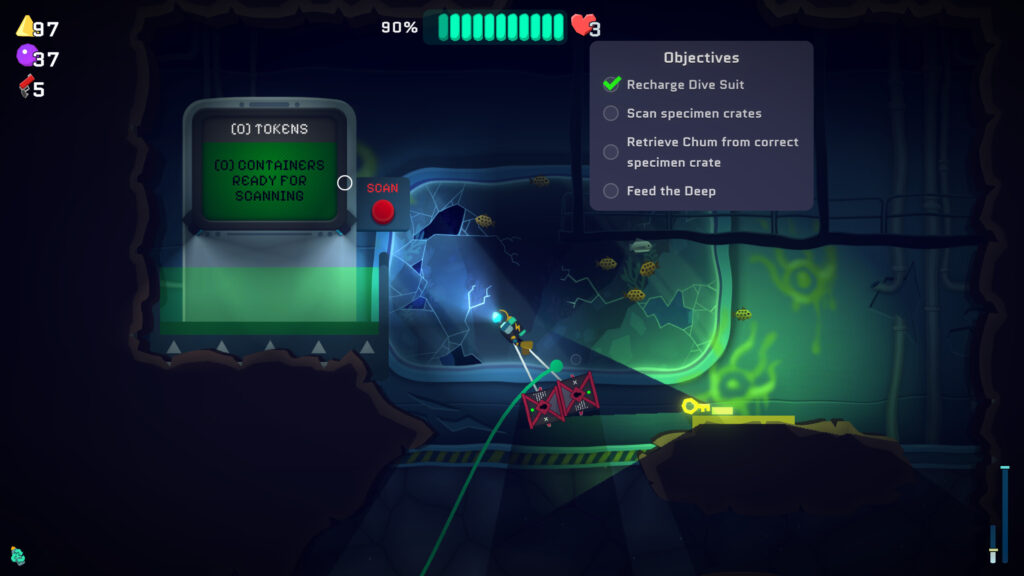Feed The Deep is an aquatic, cosmic horror masterclass in design
I love a good roguelite, and Feed The Deep is one of the best to come out in recent years. A clever balance of rules, design and procedural logic come together to create an experience full of tension and urgency.
When you first see Feed The Deep, it might give off the wrong impression. The start of each level, that first moment of gameplay, is bright and colourful — a cartoony diver bobs in a bright blue pool of water. All of the UI seems friendly, bright and clear, with simplistic, stylised imagery for the items. Even the core concept of hooking and dragging around items feels innocent and pleasant. This is all an amazing subversion, because a few minutes in you’ll be nervously shining your torch around as you try to push your luck diving deeper than you should into deadly, dark danger.
Feed The Deep is, deliberately, a carefully designed roguelite thriller: An amazing balance of suspense, choice, preparation and — hopefully not, but often, and suddenly — reflexes.
I’ve played a lot of horror games over the years, and I often feel their fearful intent’s hooks deep in me right up until I’m first killed by the monster, after that the illusion is shattered and I’m less affected by its power over my character. Here, however, the monsters are strange alien things that can come from nowhere… critically though, they’re not the only threat. Scarcity, greed and time are.
Feed The Deep is, then, deliberately a carefully designed roguelite thriller that’s also a Survival Horror.
When I first started playing I respected the structural design. I really enjoyed how each of the missions had a maximum starting depth that you could dive to; That you — as the player — get to decide how much to overload yourself by tagging more materials and gold for your next store visit, but that you have to deal with it slowing you down to a crawl if you get too greedy; and I especially liked that the storefronts were easy to understand, and that I never needed to use more than WASD, Space, Shift and the mouse. There’s a really fundamental logic there that’s reminiscent of early games and also games that Feed The Deep’s designer, Luke Muscat, worked on before this effort — Jetpack Joyride and Fruit Ninja.

I didn’t think that my enjoyment was going to get past the concept of powering up in the shop though, and was pretty convinced that I wouldn’t need the extra items like the fan for clearing silt, or the guide lines for leaving indicators of the paths I’d taken. But, Feed The Deep gets smarter and more complex the further you push into each of its six levels. Soon you’re blowing holes in walls, remotely opening doors and teleporting… and that’s just talking about changes to your traversal method.
You need to keep pushing forward into the darkness, and into danger, because the resources you need to complete your mission are scarce and finite. Ammo and upgrades become more expensive with each purchase, as do ‘lives’ (which are useless if you start drowning far from air) — but you’ll lose the whole level if you die. You only have three lives at once, and you’ll lose one of those if a monster so much as touches you. Some will strike from the shadows, others will linger in space or move around the level. You can get rid of them by shooting them with your flaregun, but that takes a while to wind up, and there’s only so much ammo available; you can bomb them too, but they move fast and bombs take a while to detonate.

Your reward for spending expensive ammo on killing a monster? A little bit of safety — that’s it. They don’t drop anything when you kill them, you just know that there’s one less ambush out there blocking your next resource run, meaning you might just be able to make it back to the store without drowning.
That all comes together to make for a really tense experience. A few minutes in and you’ll have cleared areas and paths, there’ll be a bit of doubt that its entirely safe, but you’ll have to bob and weave to reach the new areas you’ve discovered. You never truly feel safe, but you have to deal with that because its the only way to get more resources and advance your objectives. Guides, lights and lanterns can help, but are finite and… just because its well lit and seems clear doesn’t mean its safe.
Feed The Deep feels perfectly balanced and complete; It feels tense and unforgiving. Success here feels exhilarating and rewarding. It’s a masterclass in roguelike, procedural design like Slay The Spire and Spelunky.
Feed The Deep is available now for PC and Mac.
Comments are closed.